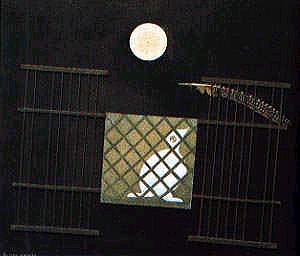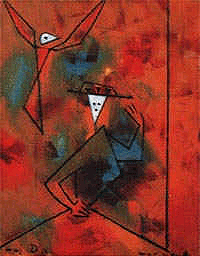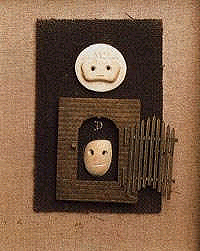|
The importance of being Ernst
|
|
|
Max Ernst led an extraordinary life. As a member of both the Dada
and Surrealist groups, he played a pivotal role in shaping the art of
the 20th Century. The works on display at the Tokyo Station Gallery provide
a glimpse of the range of styles and techniques adopted by this versatile
artist. The majority of the works are sculptures in bronze, but there
are also paintings, assemblages, prints and photographs of the artist.
The highlight of the exhibition is the series of "D" paintings
and other mixed media works. Displayed in the rough red brick room of
this gem of a gallery, these works express the vitality and ingenuity
for which Ernst is renowned. The letter "D," found within each of the
works, is the first initial of Ernst's life-long companion Dorethea Tanning.
She was an artist and poet in her own right and Ernst was devoted to her.
Several times each year he gave her works of art dedicated with the letter
"D."
|
|
| These "D" works were often experiments in which Ernst
developed new techniques, but they clearly display the creative power and
energy of the artist. Included are works in which he has scraped, sprayed
and smeared paint. In "D 1943" we see how Ernst explored the effects in
paint of mixing incompatible elements such as water and turpentine to create
a strange fantasy-like landscape. He then worked back into this experimental
background by adding painted elements such as a sky and moon. In "D 1964"
Ernst assembled found objects such as stones and cardboard together with
bits, like a gate from a child's dolls house, to create a tableaux of faces,
gate and moon. |
|
| Unfortunately, the exhibition contains little of Ernst's
early Surrealist and Dada painting and the collages for which he is best
known. These revolutionary early works suggested (rather outrageously for
the time) that art could be no more than an accident of marks made by the
subconscious mind. They changed the traditional concept of art and challenged
European society's values. This exhibition, however, is awash with Ernst's
bronze sculptures from the 1960s and 70s. These sculptural works draw heavily
on his interest in African and Native American art. Reminiscent of the sculptures
of Picasso, they mix myth and magic, objects and animals to create anamorphic
forms. Like smiling bronze Pokemons, these late works seem almost too cute
for the artist who shocked the world in the 1920s and 30s. |
|
| Within the Ernst exhibition is another, almost self-contained,
exhibition of photographs. Ernst was photographed by almost every major
photographer of the 20th century and included here are photographs by Man
Ray, Lee Miller, Bill Brandt, Yousuf Karsh, Irving Penn and Lord Snowdon
to name but a few. The photographs include historical group shots of the
Dada collective and glamorous portraits of the artist. |
|
| The insightful photographs by Lee Miller of Ernst wearing
a Native American mask in his studio make it easy to see the link between
the imagery on the mask and Ernst's own art on display. These photographs
also expose an important issue to which there is no reference in this exhibition.
The problematic relationship between artists, such as Ernst and many others
working in the first half of the 20th century and the art of non-western
peoples. Whether Ernst and his Surrealist mates were nobly raising world
consciousness to the power and beauty of what they knew as "Primitive" art,
or simply appropriating it as their own creativity, is a vexed question
not explored in this showing of his work. If you are yet to visit this charming
gallery in Tokyo Station, then a treat awaits you and this exhibition is
a good one to begin with. |
|
|
Tokyo Station Gallery
Tel: 03.3212.2485 10:00-19:00 (closed Mondays)
Max Ernst through October 1 Adults ¥800, Students ¥600,
Children ¥400
|
|



